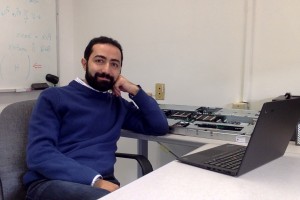
College of Science Assistant Professor of Physics and Astronomy Ehsan Khatami had research published in September 2016.
San Jose State University College of Science Assistant Professor Ehsan Khatami’s research on ultracold atomic gasses has been published in Science, “Observation of Spatial Charge and Spin Correlations in the 2D Fermi-Hubbard Model,” released on Sept. 16. The article is a collaboration between Khatami and other researchers at five universities.
“If you bottle up a gas and try to image its atoms using today’s most powerful microscopes, you would see little more than a shadowy blur,” according to a press release from MIT on the work. “Atoms zip around at lightning speeds and are difficult to pin down at ambient temperatures. If, however, these atoms are plunged to ultracold temperatures, they slow to a crawl, and scientists can start to study how they can form exotic states of matter such as superfluids, superconductors and quantum magnets.”
The Hubbard model is the simplest theoretical model of interacting quantum particles hopping around on a lattice, effectively simulating electrons in the crystal structure of atoms in solids. Only in certain situations can properties of the model be calculated. In other more interesting situations, e.g., when it is relevant to superconductivity (the phenomenon of zero electrical resistance), not even the most powerful computers in the world can solve the model. So, the experimentalists are trying to simulate it using ultracold atoms.
Khatami said the improved understanding of the Hubbard model in two dimensions will help scientists uncover the mysteries of high-temperature superconductivity and other exotic phases of matter.
“It moves us forward in the direction of material by design, using strongly-correlated materials that hold the greatest promise for future technology, transportation and energy applications,” Khatami said.
In the past decade, scientists in the Atomic, Molecular, and Optics (AMO) community have been trying to cool down (to only slightly above absolute zero temperature) and study clouds of thousands of atoms they have mastered to confine in a small region of space, typically several microns wide, using optical traps, potential wells created by lasers. They also impose an “optical lattice,” created by crisscrossing laser beams to mimic the lattice structure in the Hubbard model.
“The long-term goal of experimental efforts in this field is to cool down the atomic cloud to even lower temperatures and find out whether the theoretical Hubbard model can describe the superconducting phase,” Khatami said.
Khatami and his colleague at Pennsylvania State University Dr. Marcos Rigol had published a numerical solution of the two-dimensional (2D) Hubbard model in 2011 that piqued the interest of Dr. Martin Zwierlein, of MIT. The trio worked with seven other researchers from five universities.
“Dr. Zwierlein was wondering if we could use the same numerical method (NLCE-the numerical linked-cluster expansion) to calculate new properties they had measured in their experiment so that they could compare with their results and characterize their system,” Khatami said. “One of the surprising findings has been that lattice sites with pairs of atoms seem to be ‘bunching’ together with empty sites. “
The current article follows another related work by Khatami and his collaborators published in the March 2015 issue of Nature, “Observations of antiferromagnetic correlations in the Hubbard model with ultracold atoms.” In the article, researchers described how long-range magnetic correlations of ultracold atoms in three-dimensions were observed in optical lattices for the first time. The paper was deemed a “hot paper” by ISI in March as one of the top .1 percent of papers in its academic field due to the number of citations it received.
Khatami said for his parallel numerical calculations, he extensively used a computer cluster he put together last year using startup money provided to newly hired tenure/tenure-track faculty, and with support from the Physics and Astronomy Department and the College of Science. The cluster, called Teal, has four nodes, 54 cores, and more than 760 GB of RAM.